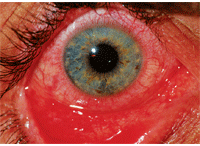Q: I recently referred a patient with severe rosacea with dermatologic and ophthalmic manifestations. The dermatologist who was consulted has recommended Intense Pulsed Light (IPL) therapy. How does it help the skin, and is there any benefit for her meibomitis or dry eye?

A: Intense Pulsed Light therapy, a fairly new treatment modality for rosacea and various other skin conditions, uses high-intensity broad-spectrum (infrared to blue) light pulses that penetrate the skin to reduce pigmentation. It’s also used for hair removal. But recently, this technology has received some attention from the ophthalmic community for its role in dry eye and meibomitis management.
Patients with this dermatologic condition experience a thickening of secretions and oiliness and hyperplasia of the glands around the nose and eyes. The oiliness of the glands causes bacteria to develop, which, in turn, causes inflammation, redness and in some cases, acne. In rosacea patients, light chromophores in IPL are absorbed by red and brown pigment, helping with dispigmentation. But, in addition to these symptoms, many rosacea patients also exhibit ocular manifestations, such as meibomitis, blepharitis and dry eye.
Joseph A. Eviatar, M.D., of Chelsea Eye & Cosmetic Surgery Associates in downtown Manhattan explains that the reason for ocular involvement is that meibomian glands don’t function properly, causing the tear film to evaporate more quickly.
“IIPL works in two ways: It constricts the blood vessels, reducing inflammation in the skin as well as generating heat which helps with the secretions,“ he says.
But, does IPL help dry eye? “When it comes to rosacea,” explains Dr. Eviatar, “it’s the oily component of the tear glands that’s usually the problem. Whether you treat rosacea with oral medicine, topically or with IPL, you tend to get improvement of the oiliness around the lids as well as the skin—even if you’re not treating the lid directly, you get some improvement.”
While Dr. Eviatar has been using IPL as part of rosacea management for about seven years, he always attempted to avoid the thin eyelid area. More recently, however, with IPL being linked to ocular rosacea relief, doctors at Chelsea Eye have begun to treat the eyelid—and with good results.
Dr. Eviatar notes that short-term effects of IPL in dry eye patients are evident within the first 24 hours of treatment. “The heat delivered through IPL liquefies the stagnant secretions, and these patients feel relief that is almost immediate.” In the long term, ocular symptoms are kept at bay due to decreased blood supply and inflammation.

Rosacea patient with marked ocular inflammation.
“We don’t have good clinical trials showing that IPL is effective in ocular rosacea and dry eye, but in our experience, there is a subset of patients with red lid margins and broken blood vessels who seem to benefit from this therapy the most,” says Dr. Eviatar.
IPL therapy for ocular rosacea requires three to six treatments that are performed two weeks apart. Dr. Eviatar describes the therapy as “Tolerable, but not very pleasant; it’s like a rubber band being snapped on your skin,” he says.
It’s important to note that this use of the IPL treatment is off-label and not covered by insurance.

